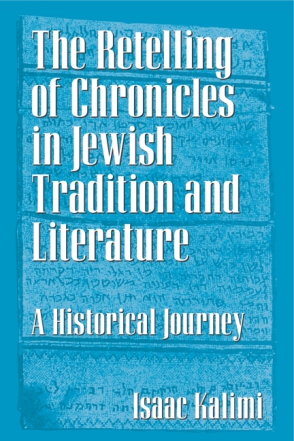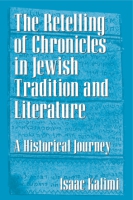
The Retelling of Chronicles in Jewish Tradition and Literature
A Historical Journey
Isaac Kalimi
The Retelling of Chronicles in Jewish Tradition and Literature
A Historical Journey
Isaac Kalimi
Isaac Kalimi reveals the history of the book of Chronicles from Hellenistic times to the beginning of critical biblical scholarship at the dawn of the 17h century. This comprehensive examination focuses, first and foremost, on the use of Chronicles in Jewish societies through the generations and highlights the attitudes and biases of writers, translators, historians, artists, exegetes, theologians, and philosophers toward the book. The reader is made aware of what the biblical text has meant and what it has “accomplished” in the many contexts in which it has been presented.
- Description
- Table of Contents
Throughout the volume, Kalimi strives to describe the journey of Chronicles not only along the route of Jewish history and interpretation but also in relation to the book’s non-Jewish heritage (namely, Christianity), demonstrating the differences and distinctiveness of the former. In contrast, the majority of commentaries on Chronicles written from the mid-19th century to the present day have contained little or nothing about the application, interpretation, and reception history of Chronicles by Jews and Christians for hundreds of years.
Chapter 1: Introduction
1. The Book of Chronicles and Its Status in the Hebrew Bible: Past and Present
2. The Purpose and Significance of the Current Study
3. The Present State of Scholarship
4. Sources, Methodological Approaches, and Coverage
Part 1: Chronicles in the Hebrew Bible and in the New Testament
Chapter 2: Chronicles’ Use in the Hebrew Bible
1. Introduction
2. Use of Chronicles in the Books of Qoheleth and Daniel
3. The Use of Chronicles in the Book of Joshua
4. The Placement of Chronicles in the Hebrew Canon/Tanak
5. Chronicles as One of the Writings
6. Why Was Chronicles Located after Ezra–Nehemiah?
8. Conclusion
Chapter 3: Chronicles’ Use in the New Testament
1. The New Testament as a Jewish Literary Heritage
2. Chronicles and the New Testament
3. Murder in the Temple: The Chronicler’s Story of the Priest-Prophet Zechariah: Literary and Theological Features, Historical Credibility and Impact
4. The Story about the Murder of Zechariah in the Gospels and Its Relation to Chronicles
5. Matthew 23:34–37 and 2 Chronicles 36:15–16
6. The Murders of the Messengers: Stephen versus Zechariah and the Ethical Values of the “New” versus the “Old” Testament
7. Robbers on the Road to Jericho: Luke’s Story of the Good Samaritan and Its Origin in Kings/Chronicles
8. Chronicles and the Genealogies of John the Baptist and Jesus
9. “Deliver Us from the Gentiles”: Possible Use of 1 Chronicles 16:35a in Acts 26:17a 65
10. Conclusion
Part 2: Chronicles in Jewish Hellenistic Sources
Chapter 4: Chronicles in the Apocrypha and Pseudepigrapha
1. Apocrypha
2. Pseudepigrapha
3. Conclusion
Chapter 5: Chronicles in the Septuagint, the Judeo-Hellenistic Historians and the Philosopher Philo
1. Chronicles and the Septuagint
2. The Use of Chronicles by Judeo-Hellenistic Historians
3. Chronicles and the Jewish-Hellenistic Philosopher Philo of Alexandria
4. Conclusion
Part 3: Chronicles in Ancient Texts and Ancient Art
Chapter 6: Chronicles, the Dead Sea Scrolls, and the Cairo Geniza
1. A Fragment of Chronicles: 4QChr (= 4Q118) 109
2. The Use of Chronicles in the Qumran Manuscripts
3. “Prayer” of Hezekiah and Isaiah (4Q448)
4. Chronicles and the Cairo Geniza
5. Conclusion
Chapter 7: Chronicles at Dura-Europos and in the Cognate Arts
1. The Number of Jesse’s Sons according to Samuel and Chronicles
2. Dura-Europos Synagogue and Its Fresco: Samuel Anointing David
3. Excursus: The Number of Brothers—The State of the Research
4. Josephus, the Artist of Dura-Europos, Rabbinic Sources and Medieval Christian Art
5. Conclusion
Chapter 8
Chronicles in the Mosaic Inscription of the Ancient Synagogue at Ein-Gedi
1. The Mosaic Inscription and 1 Chronicles 1:1–4
2. The Mosaic Aramaic Expressions and Chronicles
3. The Use of 1 Chronicles 1:1–4 and the Aramaic Expressions
in the Mosaic Inscription: An Observation
4. Conclusion to Part 3
Part 4: Chronicles in Classical Rabbinic Literature
Chapter 9: Chronicles in the Mishnah, Talmud, and Midrash
1. Introduction
2. Unity, Authorship, and the Relationship of Chronicles to Ezra–Nehemiah
3. Mishnah Yoma: The Reading of Chronicles to the High Priest
3. Chronicles in the Talmudic and Midrashic Literature
5. The Genealogical Lists of Chronicles and the Rabbinic Midrash
6. Conclusion
Chapter 10: Targum Chronicles: Historical Setting, Lack of Interest, and Translation Methods
1. Introduction
2. Translation Methods of Targum Chronicles
3. Conclusion
Chapter 11: Chronicles in Jewish Liturgy and Religious Ritual
1. Introduction
2. Prayers and Blessings
3. Haftarot
4. Passover Haggadah
5. Appendix: The Lord’s Tefillin
6. Conclusion
Part 5: Chronicles in Medieval Jewish Literature
Chapter 12: Medieval Jewish Biblical Interpretation: Comments and Commentaries on Chronicles
1. Introduction
2. Saadia Gaon and the Book of Chronicles
3. The Commentary on Chronicles Ascribed to Saadia Gaon’s Student
4. The Translation of the Karaite Japheth haLevi haBasri
5. Rabbi Jonah Ibn Janah
6. Rabbi Judah Ibn Balºam
7. Pseudo-Rashi on Chronicles
8. Rabbi Shlomo Yitzhaki (Rashi) and Chronicles
9. Rabbi Abraham ibn Ezra
10. Rabbi David Kimchi (Radak)
11. Tanhum ben Joseph Yerushalmi and Chronicles
12. Rabbi Samuel Masnut and His Work on Chronicles
13. Rabbi Benjamin ben Judah Bozecco on Chronicles
14. Gersonides (Ralbag) on Chronicles
15. Abarbanel and Chronicles
16. The Metzudot Commentaries on Chronicles: Rabbis David Altschuler and Jehiel Hillel Altschuler
17. The Lost Commentaries of Rabbi Joseph Kara and Rabbi Meyuhas
18. Chronicles’ Interpretation in the Responsa
19. Conclusion
Chapter 13: Chronicles in Medieval Jewish Mystical Writing: The Zohar
1. Introduction
2. Chronicles and the Zohar
3. Conclusion
Chapter 14: Chronicles in Medieval Jewish Poetry
1. Introduction
2. Solomon Ibn Gabirol
3. Moses Ibn Ezra
4. Judah Halevi
5. Murder of Zechariah: Chronicles, Rabbinic Legend, and Judah Halevi’s Lamentation
6. Murder of Zechariah in a Qina for the Ninth of Ab
7. Conclusion
Chapter 15: Chronicles in Medieval Jewish-Christian Disputes
1. Introduction
2. Use of Chronicles in Historical Disputes
3. Use of Chronicles in Polemical Writings
3. Yair ben Shabbetai da Correggio, A Two-Edged Sword
4. Conclusion
Part 6: Chronicles and the Dawn of Modern Jewish Biblical Critical Scholarship
Chapter 16: Chronicles on the Threshold: Azariah de’Rossi, Uriel da Costa Joseph Solomon Delmedigo, and Baruch Spinoza
1. Introduction
2. Azariah de’Rossi
3. Uriel da Costa
4. Joseph Solomon Delmedigo
5. Baruch Spinoza
6. Conclusion
Chapter 17: Summary and Conclusion
In General
In Particular
All in All
Bibliography
Indexes of Authors, Scripture, Ancient Sources, and Subjects
Mailing List
Subscribe to our mailing list and be notified about new titles, journals and catalogs.



